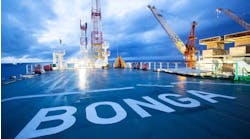Shown is a recent 90-km umbilical utilizing two 10 sq mm triad power cables and two 10 sq mm twisted shielded pair signal cables. The fiber optic cable is broken out to show the fibers can be laid into a single, seam welded metal tube or into multiple channels of a slotted structure, covered with a seam welded metal tube.
Nearly two decades have passed since the oil industry began to develop subsea fiber optic technology for long distant and high volume data transmission in support of innovative subsea production control systems. Until recently, that technology has gone largely unused because subsea connection methods had limited availability, were very expensive, and lacked adequate reliability, also they provided poor optical signal distribution capabilities.
By applying current fiber optic technology, the offshore industry can now realize higher data transmission capabilities, lower umbilical costs, and increased system operability. This can be accomplished while still using conventional off-the-shelf electrical subsea control modules (SCMs).
During the early concept development stage, three options were identified as the most probable signal distribution methods:
- Optic fibers run to the subsea field are distributed to each subsea facility component(s) using optical splitters.
- Individual optic fibers from the surface host facility run to each subsea component.
- Optic fibers from the surface host facility run to a subsea optical/electrical conversion pod, which would provide standard electrical distribution to each subsea component.
Existing subsea fiber optic production control systems are generally employing Option 2, with either two or four individual optic fibers (single or dual redundancy) connected to each subsea production tree. This option can lead to high fiber count cables resulting in a more expensive fiber optic signal cable relative to copper signal cable options. However, Option 3 offers a means of minimizing fiber optic cable cost, and avoiding redesign and recertification of standard subsea control modules.
Perceived obstacles
Several major misconceptions have stood in the way of using subsea fiber optic signal lines for subsea production controls systems. One misconception is that subsea fiber optics is a new development effort that still requires a significant amount of additional work to produce reliable systems (particularly in subsea cables and connectors). In reality, subsea fiber optic systems have been used by the telecommunication industry for two decades.
The level of communications capacity has advanced from approximately 4,200 voice channels per electric cable in 1983, to more than 640,000 voice channels per fiber pair. Telecom cables normally have 5-10 fiber pairs per cable, providing several million channels. Approximately 50% of present subsea fiber optic applications are data transfer. It is forecast that data transmission applications will account for 95% of the year 2010 fiber optic capacity.
It should also be noted that there has been extensive development in the design and manufacturing of marine cable systems, with or without repeaters. This has significantly improved system reliability. In the past, communication carrier companies expected at least 25 umbilical and repeater repairs per year per transoceanic cable. The upcoming TAT-14 (Trans-Atlantic Telecom) cable is expected to have 1-2 repairs during its entire 25-year life. Multi-billion dollar telecom projects using subsea fiber optics are currently underway throughout the world.
Connectors
Another misconception is that subsea make-break fiber optic (SMBFO) connectors are new, untested, and unreliable. Several companies began producing the first generation SMBFO connectors for the defense and offshore industries approximately 20 years ago. Present day connectors are third or fourth generation SMBFO connectors.
These connectors exhibited vast improvements in reliability, during several extensive testing programs. As with present day electrical subsea make-break connectors, reliability and operational improvements will continue to evolve after fiber optic connector pairs have been used offshore for several years, and final improvements to connector designs will be made based on actual field experience.
A third misconception is that fiber optic communications will require a completely new generation of more expensive and unproven fiber optic subsea control modules (SCM). Much of this perception is based on option two, using two or four individual fibers per SCM location, and having to re-certify the fiber optic feed-throughs for ever-increasing anticipated water depths.
This would add cost to the control pod and require more expensive fiber optic main and intra-field distribution cables for larger subsea fields. Option three would require a less expensive main fiber optic cable; less expensive standard electric signal cables for the intra-field distribution cables and less expensive, standard design E/H MUX control pods.
Long offsets
When the tieback distance or offset is long (greater than approximately 44 miles), electrical power transmission is aided by using surface and subsea transformers to increase transmission voltage. Power factor correction inductors are used to control electrical cable characteristics from the surface to the subsea facility.
For long distance electric power transmission, it is advisable to increase transmission voltage to reduce power cable size and to bring the voltage back to standard supply levels using a retrievable subsea step-down transformer. Transformers and three-phase power transmission were used to reduce the size, weight, and cost for the 63-mile Shell Mensa electrical umbilical (OTC Paper 8630). In addition, a retrievable subsea transformer module provides a location to add or subtract power factor correction inductors in the event power cable characteristics change with time.
Using the same retrievable housing as the subsea transformer, fiber optic signals from the surface can be changed to electrical signals utilizing standard electrical-MUX distribution technology to the individual SCMs. This is economical if the tieback distances become long and a retrievable subsea power transformer module becomes necessary. Once a retrievable subsea transformer module is used, the addition of an optical-to-electrical conversion module/modem in the same housing has a minimal system cost impact.
With this arrangement, a four-fiber cable can use present day technology to provide dual redundant electric signal capability for 10-15 subsea wells that are offset 1-6 miles from a central distribution point that is 50-93 miles from the host production facilities.
The optical-to-electrical conversion module/modem acts both as a subsea repeater station and an optical/electric signal conversion point. The electrical side is designed for the field particulars such as distance and speed requirements (1,200 baud or 9,600 baud) for communication from the transformer/communication pod to the subsea tree and/or manifold SCMs.
The fiber optic system can be used for the higher data rate systems envisioned for smart trees and high data rate sensor package concepts. The intra-field electric cable requirements are dictated by distance and communication speed. The field SCMs communication modem requirements are kept simple by using electric signal methods and having a relatively short transmission distance.
The bottom line
With the advent of long to very long tieback distances, the value of increasing electric power and signal transmission capabilities in the umbilical provides the operator with potential infrastructure assets. These assets can be either additional capacity for the operator's own internal expansion plans for the field area, or the ability to provide an in-place electric power and communications infrastructure to other field developments.
Many subsea fiber optic cables have the ability to place 4-20 fibers within the same size cable structure, with some structures able to carry more than 20 fibers. The fiber optic cable structure houses the fibers within a hermetic tube that protects the fibers from hydrostatic pressure, hydrogen, and hydroxyl ions, which can impair or stop the transmission of light through the glass fiber.
The fiber optic cable structure also includes the required strength members to provide tensile support for the optical fibers during the umbilical manufacturing and installation phases.
The fibers in the fiber optic cable can be laid into a single, seam welded metal tube or into multiple channels of a slotted structure, which is covered with a seam welded metal tube. Both fiber repositories are then filled with a hydrogen scavenging gel to protect the fibers from stresses and hydrogen. The individual channels of a slotted structure core can normally accept 1-10 fibers.
In many subsea fiber optic cables, the basic cable structure can accept at least 20 fibers. The cost to increase the capacity of a subsea fiber optic cable from one field (4 fibers) to four fields (16 fibers) will only be the additional cost of the 12 fibers. Using 4 fibers for each additional field with 10-15 SCMs per field, the optical cable cost increase for each additional production field is approximately $0.80 per meter or $72,000 in fibers for a 56-mile fiber optic cable. As an example, to provide an additional three production fields of signal communication capacity (an increase of 12 fibers for a total fiber count of 16 fibers) to an existing 56-mile fiber optic cable with 4 fibers, would increase the fiber optic cable cost approximately $216,000.
Scale economics
Increasing the electric power transmission capabilities (increasing the power conductor size) in the same 90 km umbilical to support the same level of infrastructure growth discussed above would have a more significant impact on the umbilical size, weight, and cost.
This would also impact the availability of vessels that could perform the installation. As an example, to install a 90-km electrical umbilical with the electrical power capacity for four 10-well fields would require a large (approximately 2,000-metric-ton carousel) installation vessel.
While it is costly to include the additional electrical power and signal capacity in the umbilical, the additional cost is only about 15 % of the cost required to lay three additional 56-mile electrical umbilicals from a surface facility to each of the three additional subsea fields indicated above. The availability of an in-place electrical power and communication infrastructure could determine which facility an operator selects as the host production facility.
In summary, fiber optic technology is available and prepared to provide an economical alternative to total electrical power and communication umbilicals for long distance subsea tiebacks. Fiber optic concepts provide a low cost, in-place infrastructure that can be used for adjacent or nearby field developments.
In addition, fiber optic cables provide a communication system that can be used either in the present slower data transfer rates, or for the higher data rate systems envisioned for smart trees and high data-rate sensor package concepts.
Author
Jerry C. Collins is a supervising engineering specialist for Intec Engineering, Inc. with 25 years experience in the design and installation of subsea control systems and umbilicals. He has been responsible for design specifications, FAT and SIT testing and umbilical installation for three of the deepest and longest umbilicals recently deployed in the Gulf of Mexico. He holds a BS in Ocean Engineering from California State University.




